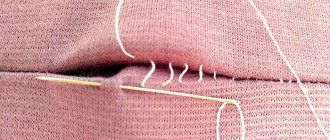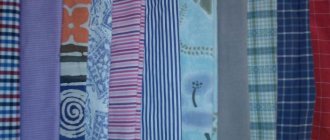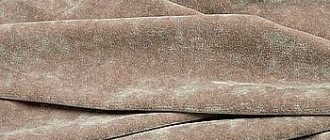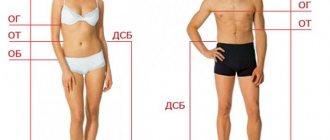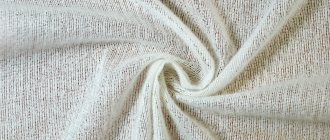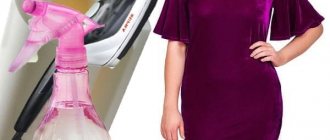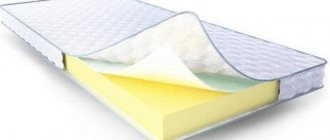What are adhesive fabric and interlining materials used for, and how to use them? Adhesive and cushioning materials such as adhesive dublerin, adhesive fabric and adhesive interlining are widely used in sewing clothes, especially shoulder products. They give additional rigidity and shape to parts or areas of clothing, for example, a collar, flap, cuff, etc. Adhesive materials must be used when sewing a jacket, coat, etc. The front, sleeves, and collar of such clothing must “keep their shape” and therefore the fabric it needs to be “strengthened”, given additional rigidity.
Such materials (usually fabric-based) have an adhesive coating on one side and are therefore called adhesive fabrics. Not only fabrics, but also materials, such as non-woven fabric, can be adhesive.
This video shows how to duplicate three different types of fabric with fabric adhesive. Each type of fabric (suit, cotton, knitwear) requires a special type of adhesive fabric.
You will no longer need to hem the bottom of your trousers or skirt by hand or using a special machine if you use adhesive double-sided “gossamer” tape. Often, to give additional rigidity to individual areas of clothing or parts, all kinds of non-adhesive cushioning materials of varying thickness and density are used.
Types and method of application
The material is made from thin adhesive fibers that randomly intertwine and create a weightless transparent fabric. The web is produced in the form of a tape or roll. The width of the tape varies within 5 cm. The roll available for purchase in regular stores is 90 cm.
The adhesive mesh can be double-sided or single-sided. If you need to hem an edge on a fabric where a seam is not desired, it is better to use a double-sided version of interfacing tape. Single-sided is good for strengthening seams or stiffening clothing parts.
The web can be made on a paper base with weaving in the form of diamonds or without a backing. The interlining material in the form of a mesh is more elastic, so it is recommended to use this option for knitwear. Rolled adhesive tape is suitable for sealing cutouts and hemming thick fabrics.
Similar materials are non-woven fabric and dublerin. They are used to seal and secure the edge of the product. They are all adhesive based. They differ in fabric composition and density. Dublerin is made on a fabric basis. Non-woven fabric comes with a continuous adhesive coating or in the form of dots. Both materials are denser than gossamer, but their adhesive strength is weaker.
A simple pattern and description of an elegant chiffon dress with lining
A light, elegant, elegant dress is the dream of every woman, but not everyone has the opportunity to buy such a product. First of all, this applies to ladies with chic volumes. At the same time, you shouldn’t despair, because you can sew such a dress from chiffon yourself. We offer a simple pattern for girls with size 52 with a length of one meter below the waist. Let's take for it:
- 4.30 m of peach-colored crepe chiffon with a fabric width of 1.4 m.
- 4.30 m of silk pongee (for lining) with a width of 1.4 m.
- 1 hidden zipper, 40 cm long.
- Nonwoven formband.
Pattern:
- Before sewing, it is necessary to transfer all the details of the pattern onto the fabric. You should have two upper front parts, one upper back part, one lower front part, one lower back part, 4 wedges. In addition, prepare a bias tape for the neckline 3 cm wide, 105 long. Leave 2 cm for allowances. Duplicate the lining fabric parts, except for the binding.
- Assemble the parts of the front (first sew the two upper parts of the front, then attach the upper part of the back to them) and the bottom (sew godet wedges into the lower parts of the front and back, connect these parts to each other, you get a skirt), process the neckline of the dress. Connect the top and bottom of the dress. Repeat with the lining pieces.
- When patterning the underskirt, make it 3 centimeters shorter than the main one. Sew in a zipper, finish the seams, neckline, and bottom of the dress. Use bias tape to finish the neckline. Lastly, sew on the lining.
How to use adhesive pad
The principle of fixing the tape is to melt the glue and then harden it. To do this you need to use an iron.
The tape is placed between two layers of fabric and the area is ironed with a heated surface. When melted, the glue connects the parts and secures them securely.
The adhesive strip is used in the following cases:
- when it is not possible to hem trousers or a skirt, but the edge of the product is not processed;
- for minor clothing repairs;
- to secure a patch or applique;
- for sealing decorative cutouts;
- when there is no other way to secure elements of the outfit.
When choosing a material, consider the density of the product and color. The tape can be seen through transparent fabrics.
To work with the tape you will need scissors, pins, chalk and an iron.
Varieties
There are 3 types of non-woven fabric:
- Glue.
This type is a canvas on which glue is applied. It can be located over the entire surface or applied only in dots. Double-sided non-woven adhesive, the surface of which is completely covered with glue, is needed if small parts need to be given rigidity. If the item should remain airy and light, but at the same time keep its shape, then you need to stick on a canvas with a dot coating. Non-woven fabric adhesive is permanently attached to the surface thanks to the iron.
Sample spot coverage
- Non-adhesive.
It is divided into 2 subtypes: tear-off and water-soluble. Both types are easily removed from the surface of the fabric, which is why they are very popular among needlewomen. Non-adhesive fabric is not used if it is necessary to hem the edge of a garment. It is good for embroidery. Thanks to the water-soluble type of lining material, the threads lie evenly and smoothly on the fabric.
- Thread stitching.
This is the most durable type, since it is quilted with threads on top for durability. This material helps maintain the strength of the canvas and prevents stretching of the sections. It does not add heaviness or deformation, and tolerates washing and dry cleaning well. It is mainly used for duplicating embossed fabrics.
You might be interested in Description of sisal: production and use of material Thread-stitched sample
Additional Information! Sometimes you have to glue a non-woven thread-stitched edge. It is cut from ordinary fabric. Such a tape can be from 1 to 5 cm. To make the edge more durable, it is stitched with thread and reinforced with soutache cord. This tape is mainly used for finishing the edges of trousers or skirts.
In the sewing industry, a certain brand of non-woven fabric is suitable for different types of fabric:
- N-180 - they can attach viscose, silk and wool fabric;
- N-200 - used for duplicating lavsan, viscose and cotton fabrics;
- N-410 - this type consists of stabilizing threads, therefore it is ideally combined with light and heavy types of fabric;
- S-405 - used when working with silk and viscose fabrics;
- E-420 - can be used to glue patent and artificial leather, as well as velor.
Black and white edge
Hemming light fabrics
If you need to finish the edge of a dress made of thin fabric or tulle, use adhesive web to match the product.
You can do the job by following simple instructions:
- Place the product on a flat surface so that the edge is within your reach.
- Take chalk or soap and draw a line along which you want to glue. Leave a small margin at the bottom of the hem, about half a centimeter.
- Carefully place the adhesive strip along the mark. If the tape is on paper, you need to put the tape so that the paper layer is on top. If you don't have one, use a piece of parchment and place it on the web.
- Run a heated iron over the paper to melt the glue.
- Remove the paper layer.
- Fold as needed. You can secure it in some places with pins so that the fabric does not move out.
- Iron thoroughly.
Advice! If the heating temperature is too high for this type of fabric, use a layer of gauze or cloth. Iron the hem through it.
It is important to consider that the adhesive material seals the fabric. Consider the possibility of its use before starting work.
Tricks and tips for working with elastic duplicating materials
Elastic adhesive materials are good because, while strengthening the base material, they retain its plasticity. But working with such materials is not always easy precisely because of their mobility. During the gluing process, they tend to shift and stick in the wrong way.
You can read the most important rules for choosing adhesive materials and working with them in this large and detailed review:
Sewing school: duplicating clothing parts
The tricks and tips below are for working with elastic duplicating material on a woven basis, especially thin ones.
Why do iron marks appear when ironing and how to avoid this?
So, the procedure + tricks and tips:
Step 1: Secure your work surface
To protect the ironing board from accidental sticking of adhesive material to it, cover the surface of the ironing board with an ironing iron, for example, a piece of chintz or calico.
Step 2. Fix the duplicate material
Place the piece cut from dublin on the piece made from the main fabric, align and cover with an ironing iron. There is no need to iron in the usual sense, by running an iron: the plastic thin dublerin can shift and stick incorrectly or fall into folds. To avoid this, we iron the duplicating material in sections, lowering the iron exactly from above and raising it after a second or two.
Step 3. We finally fix the duplicate material
To securely fix the dublerin on the surface of the part, iron it again, also through an ironing iron. Move the iron in a walking motion, holding it on the surface for 8-10 seconds in each area and lightly pressing the iron. Allow the duplicated parts to cool for 15-20 minutes.
Read recommendations for working with different types of adhesive pads on woven and non-woven bases (iron temperature, exposure time, etc.) here:
Non-woven gasket table
Step 4. The adhesive didn’t stick - what should I do?
Now check if the material has stuck well. Sometimes it doesn't stick properly on the first try.
Repeat step 3. In this case:
- First try increasing the pressure on the iron. If after checking the cooled part it turns out that it did not work, then...
- Increase the exposure time - hold the iron on each area not for 8-10 seconds, but 2-4 seconds longer.
Check the duplication quality only on cooled parts.
The reason that the material does not stick after several attempts may be that it is not of good enough quality. In these cases, it is worth replacing the material.
Photo: Natalya Pykhova, thelaststitch.com, amazon. de
Ironing correctly means sewing well!
Ironing rules for beginners
How to remove iron marks?
How to properly duplicate details of coats and jackets
Hemming jeans
This step-by-step guide will help you quickly shorten denim pants without using a seam. Do the following:
- Try on the model and mark the hem with chalk or secure with pins.
- Remove your pants and place them on a flat surface.
- Draw a straight fold line.
- Back off 3 cm and cut off excess fabric.
- Place the ribbon and iron it through the paper.
- Remove the paper. Fold the fabric and iron again.
Ready! Remember! Adhesive tape may lose its properties during washing. It is better to clean such products by dry cleaning or washing them rarely on a gentle cycle. Do not increase the water temperature above 40 degrees.
Repairing torn clothes
To repair a cut fabric, you can use adhesive web and a piece of fabric of the same size. To do this you need:
- If necessary, process the edge of the cut, removing threads and irregularities.
- Align the edges and place the web and overlay on top. The overlay must be placed on the wrong side. If this does not hide the defect, it is better to use an applique or patch from the front.
- Iron carefully, being careful not to move the parts.
This simple method will help you perform minor clothing repairs and save you from trouble.
Dublerin analogues
Another name for dublerin is thermal fabric, as it is used as a lining for the main product. Depending on the purpose of use and the required density, thinner or denser fabric is used for the production of dublerin.
During the sewing process, the dublerin is laid out along the grain thread, without cutting out gaps for seams, which can create additional volume.
In addition to dublerin, other lining materials are used when sewing, which are similar in properties to it.
Adhesive beading
This cushioning material is used to strengthen the fronts and sides of men's jackets and other clothing. It has two types - with an adhesive base and without an adhesive coating. Beading is much denser than dublerin and is used in rare individual cases.
Non-woven cushioning materials
Non-woven cushioning materials include non-woven and spunbond. These materials are based on cellulose fibers with the addition of polyester fibers.
Non-woven fabric, similar to dublerin, comes in different densities and thicknesses, from the thinnest and most weightless to dense fabric similar to thin cardboard.
The advantage of non-woven fabric is the ease of cutting the material. Non-woven fabric does not have a longitudinal or transverse thread, so when using it there is no need to waste time on such details.
However, non-woven fabric, along with dublerin, is widely used in tailoring due to its low cost.
Adhesive grosgrain tapes
Used when sewing belts for trousers and skirts. They come in different densities and widths and are selected individually for the product.
Glue webs, mesh, fleece
Glue webs and meshes are used to glue layers of the product. This cushioning material has no backing and is entirely woven from adhesive threads.
Gossamer is a thin and light material that is used in conjunction with thin cotton, chiffon or gauze.
The adhesive mesh is tougher than gossamer and is used with denser fabrics. Adhesive nets are sold with a paper backing that must be removed before use.
Flizofix is a double-sided adhesive sheet. Also sold as nets attached to paper or without it.
Strengthening decorative cuts
A slit in a skirt, a neckline in the neckline or on the back can be beautifully processed using a web tape. Allowances on the armhole or cut can be strengthened using the adhesive method. To do this you need:
- Measure the length of the allowance and cut off the corresponding piece of tape.
- Place the strip into the armhole.
- Iron thoroughly.
Advice! Pre-test the quality of the tape on any unnecessary scrap. If the material does not adhere well even at high temperatures, it is better not to use it and purchase another one. This type of glue will not stick. This can happen if the adhesive material has been stored incorrectly for a long time or is made from low-quality raw materials.
Summarize! Glue web is a universal way to solve many everyday problems related to sewing and mending clothes. It can replace the hem of trousers, hide defects in outfits and seal cuts.

